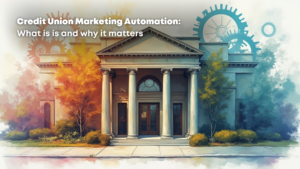Your credit union’s marketing automation program will be as successful as its campaigns. And for the most part, we don’t mean outbound campaigns… we mean nurture sequences.
Unfortunately, credit union nurture campaigns don’t set themselves up. You’ll need to:
- Identify a product or service to market
- Find or create informative content about it
- Put that information in front of the people who show interest in it
- Last week, we shared an example of what kind of content a credit union might include in an email nurture sequence. After a few questions about what other products or services can benefit from a nurture sequence, we put together a little list.
One question we hear often is, “what kind of nurturing sequences should our credit union set up?”
The quick answer is:
Whatever you want!
The long answer is:
It depends on what kind of content your credit union has available to you. Using marketing automation, you can tie together informative content that addresses features and FAQs… and an offer.
Sending an email once or a few times per week is key to content marketing campaigns. But, just to make it easy, we included some example content and sequences to use in basic marketing automation sequences for credit union:
What Kind of Content Goes in Nurture Sequences?
To illustrate what kind of content to put into credit union nurture sequences, we’ll suggest only titles. And suggest is the operative word here—these ideas are starting points, not instructions!
If your credit union has content (such as blogs, videos, infographics, etc.) that looks like it fits our suggested topics, then you’re already part of the way there! If not, no worries! These might show you what you’re missing—or it could give you ideas for what to write about next for your inbound marketing efforts.
The following are a handful of examples for content that could be used in credit union nurture campaigns:
Auto Loans
- Leasing vs buying
- Used vs new
- How to get the best deal (time of month/year, loan rates, getting prequalified, etc.)
- Car buying risks (what not to do, what issues to look for)
- How much car can you afford?
- How to get the most value when selling or trading in an old car
Onboarding
- How (and why) to open a savings account
- Reminder to use a debit card for the first time
- How to log onto online banking
- How (and why) to sign up for electronic statements and notices
- How to set up overdraft protection (and what it is)
Credit Cards
- What’s the difference between credit and debit cards?
- What are the benefits of having a credit card?
- How can you build credit?
- Which credit card is right for you?
- What can you do with your credit card rewards?
First Mortgage
- Should you rent or buy your house?
- How much house can you afford?
- Fixed vs variable rate mortgages
- How to shop for a mortgage
- The importance of getting prequalified
HELOC
- What is a home equity line of credit?
- How can you qualify for a HELOC?
- Should you get a HELOC?
- HELOC vs home equity loan
- How to get the best rates for a HELOC
Certificates of Deposit
- What’s is a certificate of deposit and how does it work?
- Why do people invest in CDs?
- Are CDs safe?
- What happens if you cash in a CD early?
- How do I pick a CD that’s right for me?
Business Loan
- How much can you get for a business loan?
- How can you qualify for a business loan?
- What is a good rate for a business loan?
- How can you qualify for a good loan rate?
- How long does it take to pay back a business loan?
Money Market Account
- What is a money market account?
- What are the advantages of a money market account?
- What are the risks of a money market account?
- Are money market rates fixed or variable?
- Is a money market account right for you?
High Yield Savings Account
- What is a high yield savings account?
- What is a good rate for a high yield savings account?
- High yield savings accounts vs CDs vs money market accounts
- How much should you put in your high yield savings account?
- What are the dangers of high yield savings accounts?
Retirement Account
- When should you begin investing in a retirement account?
- What are the different types of retirement accounts?
- Calculator to see a projection of your retirement savings
- How much should you put into your retirement account?
- Where can you get a retirement account?
Boat and RV Loans
- How are boat / RV loans different from auto loans? How can you qualify for one?
- What is a good rate for a boat / RV loan?
- What are risks of getting a boat / RV loan? Are they a good investment?
- How much boat / RV can you afford?
- Where should you look for a boat / RV loan?
Building Nurture Sequences
Credit unions can build nurture sequences out of any of their pieces of content. Most nurture sequences are between 3 and 7 pieces of content, but we’ve put together a few that are even shorter—the goal is to stay informative and top of mind during a buying process…
And some buying processes are very short!
The types of content that you might want to use for a nurture sequence are many. In some cases, you don’t need any pre-built content at all. You can put your information, content, or CTA directly in an email. (However, it’s easier to track links clicked through an email, so at CU 2.0, we tend to prefer those.)
Some examples of good content types include:
- Blogs
- Video
- Calculators, polls, or other interactive content
- Infographics
The content you create isn’t a sales piece. Rather, it’s just there to inform your members. It can do some sales work, such as answering FAQs, addressing best fit, and letting you know who’s got the best deals (and why), but mostly it’s there to help your members make their own decisions.
In time, your transparency, value, and willingness to help will built trust. And when you show your members that you provide trustworthy financial support, they’ll look to you to help them take the next step.
Final Thoughts
If you think your credit union is ready to build nurture sequences, these should serve as a great starting point. But if you’re not sure how that would work, then it’s worth looking into marketing automation.
Which products or services would you want to build up first? Do you have the content for it? Which piece of content goes first in the sequence?
For more about credit union marketing, strategic planning, or technological solutions, subscribe to our blog.
Or just holler at us if you want help building out some automation sequences.




